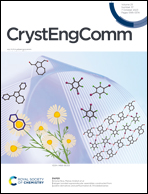Halogen bonded supramolecular assemblies constructed from azulene derivatives and perfluorinated di-/triiodobenzenes†
Abstract
Two series of binary halogen-bonded co-crystals involving perfluorinated di- and triiodobenzene (1,2-ditfb, 1,4-ditfb and 1,3,5-titfb) and 1,3-azulenedicarboxaldehyde (azdicho) 1 and 1,3-bis(4-pyridyl)azulene (azbbpy) 2 are reported. The crystal structures of the six new co-crystals show primarily O⋯I or N⋯I interactions, and the subsidiary weak C–H⋯F and π–π interactions of the aromatic units. Because the halogen-bond acceptors contain different heteroatoms and length size, the supramolecular recognition in the co-crystal is quite different. Besides novel structural features formed via halogen-bonding interactions, our results showed that the azulene moiety plays a unique organizing role in the formation and stabilization of supramolecular aggregates through π–π stacking interactions. These non-covalent interactions are investigated by theoretical studies through Hirshfeld surface analysis and DFT calculations followed by topological analysis of the electron density distribution within the QTAIM approach. The co-crystals were also investigated in solution by NMR spectroscopy through 19F-NMR and 1H,15N-HMBC experiments.



 Please wait while we load your content...
Please wait while we load your content...